
After 12+ hours of research, we found the Wenzel 8 Person Klondike Tent to be the best tent with an AC port.
Trying to fall asleep on a hot and humid summer night can be a major nuisance. A window AC unit can come to the rescue only if you have a tent with an AC port (apart from a couple of risky DIY ideas).
Typically, tents are not well-insulated, but A window AC unit will do the job. Just make sure it’s sealed and you’ll have a cool place to sleep or get away from the scorching summer heat.
That’s why our team has looked into tents with AC ports. We have done some thorough research to get all the important facts.
Here’s all you need to know about choosing a great tent with an AC port.
Top Recommendations
Best overall: Wenzel 8 Person Klondike Tent
Best tents with an AC port:
- Bushnell Shield Series Instant Cabin Tent – very roomy instant setup model
- Wenzel 8 Person Klondike Tent – airy and spacious tent with a screen area
- Ozark 16×16-Feet Trail 12-Person – huge 3-room tent with awning
- E-Z UP 6 – Person Camping Cube 6.4 – house-like tent with vertical walls
Best tents with E port:
- OT QOMOTOP Tents, 4/6/8/10 Person Instant Cabin Tent – beginner-friendly basic model, super-easy setup
- Coleman WeatherMaster 6-Person Tent – spacious and comfortable tent with a large screen room
- CORE 9 Person Instant Cabin Tent – super-ventilated model for warm weather
If you are unsure whether you need a tent with an AC port or want to learn more about what an AC port on a tent looks like, check out these sections.
And we’ve also included a comprehensive buyer guide on how to choose the best tent with an AC port.
Wenzel 8 Person Klondike Tent
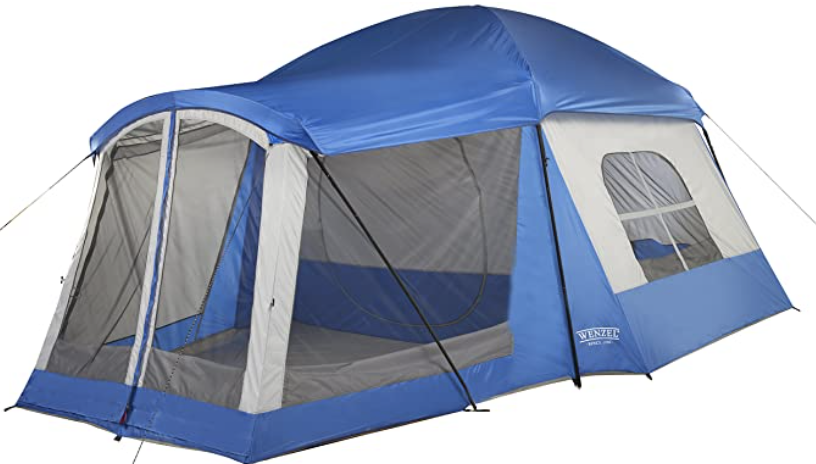
Best for: Campers who love spacious tents with screen room; $$
If you hate small, confined tents without a view, the Wenzel Klondike tent has a solution. When it comes to ventilation and broad view, it doesn’t get better than this.
With two windows in sleeping quarters and three mesh walls in the “porch area”, you’ll get perfect ventilation and excellent view in multiple directions. Furthermore, there’s a vent opening close to the ground at the back of the tent to provide additional high-low air circulation.
This back vent doubles as an AC port.
While advertised as an 8-person tent, don’t count on it. If you use the screen area for sleeping, you can fit 8 sleeping bags into it. But, if you want some comfort, I’d say it’s for up to 4 people, 5 at most.
If you don’t push it with the number of occupants, it can be a very cozy and spacious tent. Four regular-size people can easily sleep in the backroom. It allows you to use the screen room as a living room, storage space, and whatever else you can think of.
Also, if it rains, I’d rather be sitting in a spacious tent. The rain fly, polyester fabric, and PU (polyurethane) coating should keep you dry and well-protected from rain. However, the tent is designed for nice weather, and I wouldn’t count on it in sustained, heavy rain.
Pros:
- Generous floor area (98 sq. ft. + 60 sq. ft. screen room)
- Roof and window mesh panels for great ventilation
- Screen room with covers to zip up in case of rain
- Bathtub floor
- Removable water-resistant rainfly
- AC port
Cons:
- Screen room window covers can’t zip up on the top side
- Not the easiest set up. It takes around 20 minutes and it’s difficult to avoid sagging.
Bushnell Shield Series Instant Cabin Tent
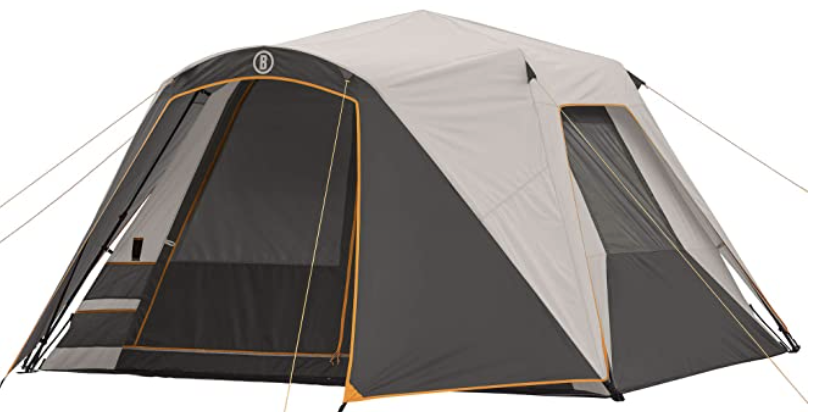
Best for: Summer campers looking for hassle-free set up; $$
After a long drive or hike, setting up the tent can be bothersome. Not with this model. It’s called an “instant cabin tent” for a good reason and you can set it up in no time.
Bushnell Shield Series includes three models for 6/9/12 persons. They are all made of the same materials with the same technology, so apart from the size they have the same or very similar qualities. To avoid misunderstanding I’ll talk about the basic, 6-person model.
The tent is moderately priced and offers great value for money. With an 11 x 9 feet base it is pretty spacious and it will fit typical campsite dimensions.
It is a 3-season tent, but I would recommend it for summer camping for several reasons.
First, it has wonderful ventilation provided by mesh panels on all sides, the roof included. All windows have covers to seal them if it gets too hot in the midday. Then, you can use your AC unit to stay cool.
Furthermore, outstanding ventilation means you don’t have to worry about condensation.
While these tents come with a rainfly and water-repellent fabric, they won’t stand heavy rain. Even a light, continuous rain will get through eventually. Some users had no issues in light rain conditions, but many have experienced leaks. So, don’t count on it to stop the rain.
You can use waterproofing spray or a tarp to improve water resistance.
So, they’re best suited for warm and sunny weather. Rainfly comes with a reflective coating on the underside that blocks UV rays and keeps the tent darker and cooler.
Surprisingly, the tent performs very well in windy conditions. Even though it has a freestanding design it is very stable and solid. I wouldn’t test it in very heavy winds, but you don’t have to worry about summer wind gusts or moderate winds.
I love the abundance of storage pockets. You can easily organize and classify your gear and other items.
Pros:
- Super-easy set up
- Spacious sleeping area
- Outstanding ventilation
- Decent stability despite the freestanding design
- Sturdy and durable steel poles
- Plenty of storage pockets
- Convenient zippers
- When zipped, no creepy-crawlies can come
Cons:
- It’s on a heavier side (27pounds)
- Low waterproof rating
- The floor is not very durable
Ozark 16×16-Feet Trail 12-Person 3 Room Instant Cabin Tent
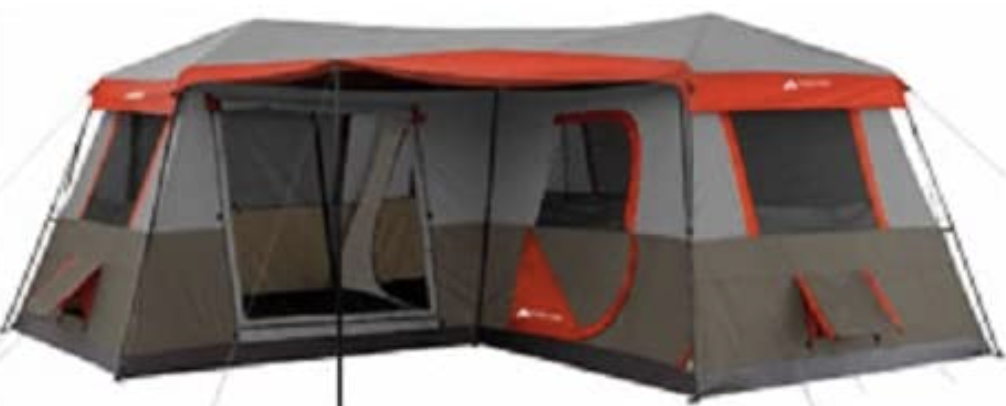
Best for: Large family and groups going on longer camping trips; $$
Not enough privacy on family or group camping trips? Tired of fighting your tent while setting it up?
Ozark 16×16 tent might be a great choice for you. With 3 separable rooms, a generous awning, and under a two-minute setup, it truly is a large but instant cabin tent.
Speaking of setup, there’s a learning curve, though. I suggest you try it in your backyard first. However, once you get the hang of it, two people can really set it up in under two minutes.
I am also very impressed with how much space this tent offers. It has an L-shape, 3 rooms and 2 doors. An awning actually represents a ¼ of the 16×16-feet base. So, you have a great many options to organize your space to your liking.
All rooms can be divided and zipped off for privacy, taking a nap, or keeping your kids in a separate room. Two doors are also convenient for the same reasons.
You don’t have to worry about the ventilation, either. The sheer size, mesh windows, and mesh roof make sure there’s a nice airflow. If it gets too hot, there are two AC ports to install an AC unit.
So, it’s a fantastic tent for nice weather, but what about rainy, windy days?
Users reported different experiences. Most of them claimed the tent stays dry even in heavy rain, while others got a little bit wet.
In my opinion, it comes down to the correct setup. The tent should be fully stretched as well as the rain fly when you use it. If you do it correctly, it should offer excellent protection against rain.
It’s the wind where this tent might struggle a bit. 25 steel poles provide great stability, but the part of the rainfly that extends over the awning becomes a liability in stronger winds. One user described it as a “wind kite”. It’s probably an overstatement, but constant flapping can be annoying.
Pros:
- Super-quick to assemble and disassemble
- Very spacious with 3 different rooms
- 7 double-layered mesh windows with covers
- Welded bathtub floor
- Spacious awning
- 82” maximum height
- 2 AC ports and E-port
Cons:
- It’s very heavy (61 pounds)
- In windy conditions rainfly flaps and picks up air
- Only one hook to hang light
E-Z UP 6 – Person Camping Cube 6.4
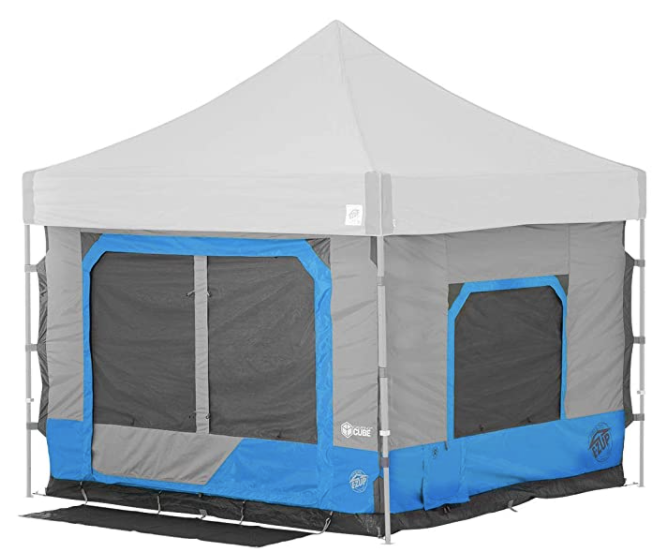
Best for: Campers who prefer vertical, house-like walls and lots of space; $$
If you have an issue with tight spaces, this house-like tent with straight walls might be your perfect match.
It is a 10’ x 10’ tent. Large space, combined with straight walls, large windows, and a high ceiling make this tent super-spacious and well-ventilated. No losing space due to inclined walls means you can use every inch of the tent.
A multitude of O-ring and clip attachment points will let you hang a bunch of things on your tent walls or ceiling.
While it looks like a little house, it takes just a few minutes to set it up or take it down.
If you want a full-glamping feel, it comes with three E ports. While the tent doesn’t have a dedicated AC port, a pet portal perfectly fits small window AC units.
The material is pretty light, but it’s sturdy and highly water-resistant. A bathtub floor is additionally sealed to offer excellent protection against the elements.
On the downside, this tent can’t stand on its own. It needs a straight-leg frame that you need to order separately. The description clearly states it’s a sort of add-on to the E-Z UP canopy/shelter. Nevertheless, it’s a bit strange to sell a tent that can’t work on its own.
Anyway, combined with a fitting frame it becomes a great and pretty unique camping tent.
Pros:
- Straight walls provide extra space inside the tent
- Plenty of storage and attachment points
- Excellent ventilation
- Extra-large entry door
- Doggy door
- UV protection
- 3 E-ports
Cons:
- It comes without a frame. You need the E-Z UP shelter/canopy to make it work.
- Front door zipper jams-up easily
- Flat roof susceptible to condensation build-up
OT QOMOTOP Tents, 4/6/8/10 Person Instant Cabin Tent
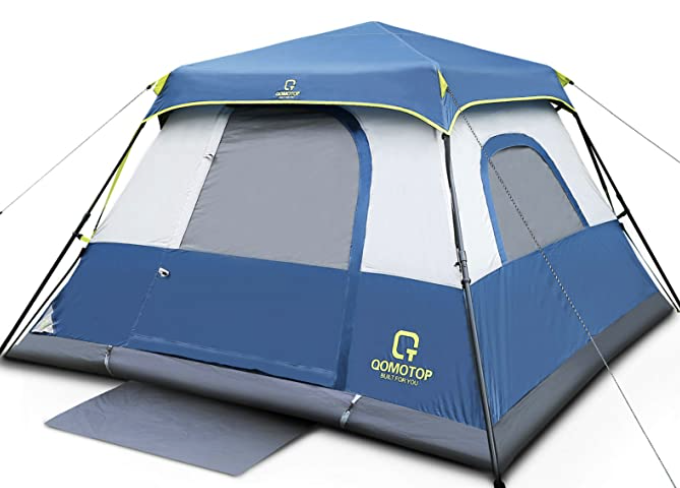
Best for: Campers on a tight budget and beginners looking for an easy setup; $
Gone are the days when it took forever to set up your tent properly. But, setting it up in 60 seconds is quite impressive. Yeah, that’s how long it takes to set up or break down this tent.
It comes in different sizes from 4 to 10 persons. As usual, subtract at least 2 people to get some comfort.
The tent is roomy enough and this is how big it really is. 4-person tent dimensions are 8 x 8 feet, so you can fit one queen-size air mattress in it, with a little bit of spare room. The 10-person tent is 14 x 10 feet, fitting 2 queen airbeds.
No bells and whistles here, but this tent is very functional and will do the job. Even though the windows are somewhat small, it’s airy and well ventilated.
A smart design combines roof and windows mash panels with a ground vent to make sure there’s a nice airflow. That’s the best way to avoid condensation inside the tent.
As for the rain protection, rainfly features taped seams and PU (polyurethane) coating, as well as the inner tent seams. This should keep you dry in case of rain.
However, the waterproof rating of 600mm is rather low, which means it won’t withstand prolonged rain. Just for comparison, a common umbrella has a 400-500mm waterproof rating.
Overall, it’s a cute, basic, and practical tent that offers good value for money.
Pros:
- Affordable price
- Excellent airflow
- Instant set up
- Can withstand moderate wind
- E port
- Beginner-friendly
Cons:
- Low waterproof rating (600mm)
Coleman WeatherMaster 6-Person Tent with Screen Room
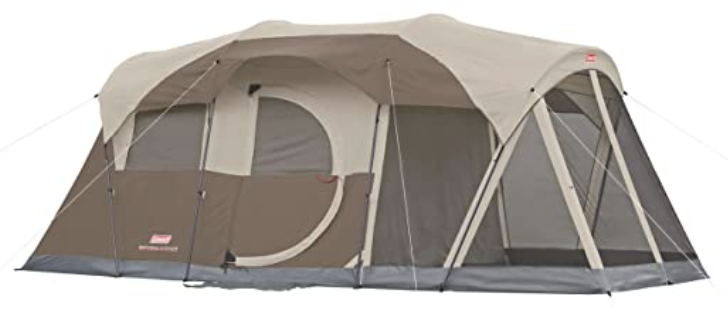
Best for: Larger camping parties or families; $$$
If you like to have extra comfort in the tent you may check out Coleman WeatherMaster 6-Person Tent with Screen Room. It offers all you need to enjoy your time inside the tent.
It’s quite big, to begin with. It easily fits two queen airbeds and you’ll still have plenty of room. With a high ceiling and a 9 x 6 feet screen room, it will never feel cramped or too confining.
I loved the hinged door for easier access. In case you need privacy, there’s a room divider – basically a piece of fabric with a zipper to separate the room. For additional comfort, you can use electrical devices as it comes with a fully protected E port.
It comes close to glamping, but what about basic features?
As for weather protection, most users have described it as capable of coping with moderate and even heavy rain. Welded floor seams, inverted seams, and coating all contribute to keeping the tent dry and safe. Specially designed poles provide strength against the wind.
There’s a caveat – rainfly doesn’t cover the whole screen room, so some rain will get into it for sure. Truth be told, this area is floorless anyway, so you’ll be fine as long as you don’t leave your stuff out there.
Still, I am a little bit disappointed with the lack of floor and cover in the porch area.
Pros:
- Very roomy
- Two doors, one hinged for super-easy in and out
- Screen room
- High ceiling
- Electric cord port
- Bathtub floor
- Can withstand rain and wind
Cons:
- A bit pricey
- For the price, I’d like to see rainfly covering the porch area as well
Core 9 Person Instant Cabin Tent
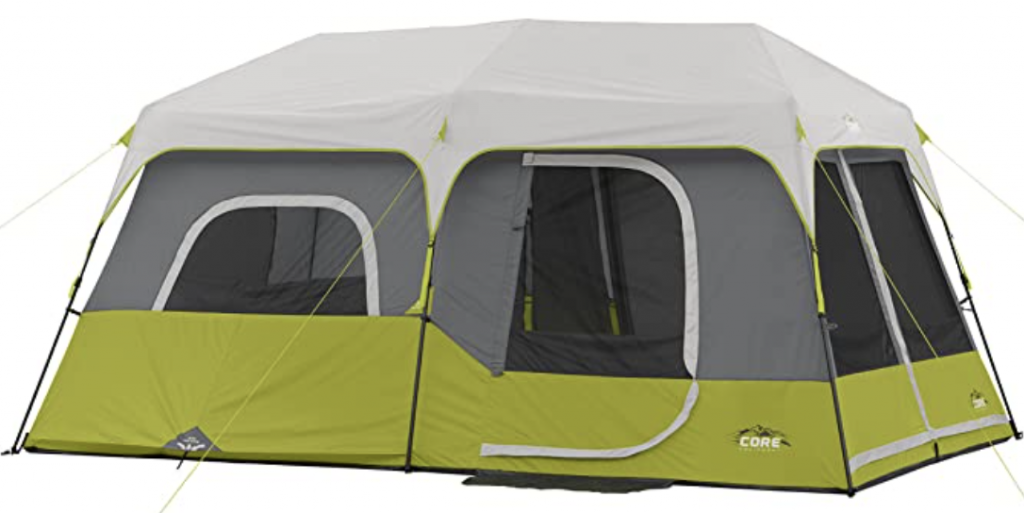
Best for: Taller people who prefer summer camping; $$
It can be intimidating when you’re tall and can’t stand upright in your tent. With a central height of 78 inches, Core 9 Person Instant Cabin Tent provides more comfort for campers.
And it’s not just the height, this tent is very roomy overall. It fits two queen air mattresses easily with some spare room left. It has almost vertical walls providing a spacious, cabin-like sensation and comfort.
Speaking of comfort, there’s more to come. Users are delighted with how airy this tent is. Large windows, a mesh roof, and two ground vents provide impressive airflow. This can become a problem in colder weather, but in the summertime, you have to love it.
Oh, and I almost forgot, it’s also super-easy to set it up. The tent has a free-standing design, pre-attached poles, so you can pitch it in 60 seconds.
So, this tent really shines in warm and sunny conditions but not so much when it gets colder. Yes, it comes with a solid rainfly, but it doesn’t cover the whole tent. It might withstand some rain, but if it’s accompanied by wind or lasts longer, chances are some water will creep in.
In the colder season, it can also get pretty cold inside the tent. There are no zippers or velcro on two ground vents, so you can’t fully close them. So, my choice would be to avoid chills and enjoy that summer breeze.
Pros:
- High ceiling (78 inches)
- Plenty of room (fits two queen airbeds)
- Room divider for privacy
- Outstanding ventilation
- Quick setup
- Fully protected E-port
- Convenient wall storage pockets
Cons:
- Too much airflow to use in cold weather
- Thin floor
What Is a Tent with an AC Port?
It sounds more intricate than it really is. It’s a regular tent that allows you to use a window AC unit. So, an AC port is just an opening where you can fit an AC unit.
How to Tell if a Tent Has an AC Port?
It’s simple and easy. Most manufacturers will mention the feature. If not, you can figure it out on your own by looking at the tent.
An AC port looks like a small window with a flap. The flap protects the AC unit from the elements. Still, I recommend a full-cover rainfly to make sure your AC unit is fully protected.
Also, you can close up the “window” if you don’t need AC in milder weather. Usually, it is placed on the side or on the back of the tent, 5 to 10 inches off the ground.
Do I Really Need a Tent with an AC Port?
Some people may think it’s going overboard or more of a “glamping”. However, the summer heat can make your nights unbearable and impossible to fall asleep. Trust me, I’ve been there.
A night of good sleep is essential to stay well-rested and invigorated for daily activities.
Summer heat can be intolerable in the daytime as well. And it may even feel hotter inside the tent. Small spaces tend to trap heat.
So, there are strong reasons to consider getting a tent with an AC port. However, it doesn’t necessarily mean that you need to buy one. At the end of the day, it comes down to your camping habits and preferences.
Camping in Hot Climate
For example, if you typically go camping only in the summer it makes sense to think about AC.
Especially if you prefer camping at the ocean, lowlands, or any other location with a hot climate.
Whether you want to avoid sweaty nights or just want to make sure you have a cool shelter to get away from the sun, a tent with a dedicated AC port can solve your problems.
Make sure you have a reliable power source, though. In all likelihood, small solar panels and batteries won’t suffice. You will need a reliable 120V power source.
Mountain Camping, Camping Combined with Hiking, Spring and Fall Camping Trips
On the other hand, spring and fall camping trips or camping in the mountains come with a different set of challenges. Hot weather is rarely an issue and there’s no need for AC.
Some people also like to keep their camping as natural as possible and prefer using only minimum protection against the elements.
An AC unit is more of a hindrance than help in most of these scenarios. So, if you prefer any of these camping styles, you don’t need a tent with an AC opening.
Can You Install a Portable, Freestanding AC in Your Tent?
Yes, and I wouldn’t even call it an “installation”. A portable unit will do the same job as a window unit, but the downside is that it takes precious space inside your tent.
Also, they are a bit noisier than their window counterparts. They are not really louder, but the noise is more apparent because they stand inside the tent.
If you prefer or already have a portable unit, then you obviously don’t need an AC port on your tent.
However, you should look for a tent with a power port. It may look like a minor thing, but it’s not a good idea just to run the electrical cord through any opening or underneath the tent’s wall.
It would allow insects, critters or water to crawl in. Dedicated E ports are protected and fully closable so you won’t have to worry about uninvited guests.
How to Choose a Tent with an AC Opening
It’s not much different from choosing a regular tent, but there are a couple of things to consider.
AC tents are just regular tents with a dedicated AC port, but some features may decrease cooling effects. So, let’s dive into it a little bit deeper.
AC Port Placement
Most tent manufacturers place AC openings on the side or back of the tent, close to the ground, like this Ozark Trail 8-Person Instant Cabin Tent.
So, you probably can’t go wrong here. Still, it’s important to check it out. You don’t want an AC port to be high or above your head. A direct blow of cold air on your head may feel good, but it’s not.
It will cause a contraction of blood vessels in your brain. In simple words, it leads to potential headaches.
Another reason to keep an AC unit close to the ground is stability. When the opening is low, a simple crate or small platform will make it stable and safe. It’s much more complicated if you need a platform 3 or 4-feet high.
The Size of the Opening
Small things make all the difference. While most AC units come in standard size depending on the power, it’s important they fit an AC opening. Any gaps will allow cold air to leave the room and diminish cooling effects.
Some manufacturers provide elastic bands to ensure a perfect fit for the unit while others use mesh to keep the tent sealed. A netted option is great to keep bugs and insects at bay. However, a window unit needs to be a perfect match for best results.
Check Out Mesh Roofs and Windows
Mesh ceilings and windows are great to provide ventilation and a view. But, it’s not what you need to cool your tent. Actually, a mesh panel will make your AC unit almost completely ineffective.
You don’t have to avoid tents with mesh panels, though. Many of them have an additional layer to cover and seal a window or roof if needed. So it’s all about preventing cold air from dissipating.
You can enjoy the view or natural airflow, just make sure to cover your mesh panels when cooling your tent.
Fabric Quality
The material quality is among the top priorities when choosing any camping tent. Typically, most tents are made of polyester, nylon, while some old-fashioned ones are made of canvas(cotton).
Each material has its upsides and downsides and they go with different camping styles.
You can read more about fabrics here.
As for tents with AC ports, polyester is probably the most common choice. It’s a durable, budget-friendly material. Nylon is somewhat lighter and stronger than polyester, but also more expensive. Canvas fabric naturally provides better insulation, but it’s bulky, heavy, and impractical.
At the end of the day, it’s more important to prevent leaks than to look for specific material.
Still, high-quality materials will make your tent more durable and more comfortable to use.
Size & Capacity
Considering the size and capacity of a tent with an AC port is the same as for regular tents. Apart from some extraordinary gigantic models, a window AC unit will have no problem cooling a regular tent of any size.
First, you need to think of how many people will usually sleep in your tent. Tent capacity provided by manufacturers is actually a maximum capacity with no extra room. As a general rule of thumb, you should look for two sizes up (if you plan 4 people get a 6-person tent).
Then, you should consider the time spent in a tent. It ranges from only sleeping in a tent to using it as a living quarter. Obviously, the more time you spend in your tent, the more comfort you’ll need, and more space will be required.
Other considerations include shape, height, and storage space. It comes down to your camping preferences and plans.
Weather Protection
Weather is everything in camping. And when it gets wet or too hot, you’ll need your tent to protect you from elements. A leaky tent will ruin your day if not the whole camping trip.
Therefore, it’s essential to look for tents with a high level of protection against rain, sun, or wind.
Of course, it depends on your camping habits and your favorite season, but it should never be overlooked.
Keeping the rain out of your tent is a top priority. No tent is 100% waterproof, but the level of water resistance varies a lot. A higher waterproof rating indicates better and longer protection from rain and leakage. But, it’s not the whole story.
The waterproof rating won’t mean a thing if tent seams are not sealed. Different manufacturers have different solutions to keep the seams waterproof. Taped, inverted, and welded seams are the most common ways and each method is effective.
So, you don’t have to bother to figure out all the technicalities. Just make sure your tent has sealed seams.
Apart from the seams, the floor is another soft spot for water to come in. Thanks to the design, bathtub floors are great to prevent leakage at ground level. A tent floor is the part that takes more beating from rubbing the surface. Therefore, it needs thicker coatings to keep the inside of the tent dry.
This brings us to the next matter: no tent fabric is waterproof by itself. It takes coating to give fabric water-repellent properties. However, coatings deteriorate over time. You should apply a new layer of coating every 1-2 years.
Additional Equipment
A tent with an AC port is just a tent with an opening. And obviously, it won’t do a lot unless you pair it with a fitting AC unit.
You don’t really need a lot of additional gear, but you can’t just hang your AC unit on a tent wall.
A dedicated stand or a simple crate will make it stable and ready to bring some fresh air into your tent.
Is It Different from Choosing a Regular Tent?
By now, you should know the answer. I’ve mentioned all the specifics already, but I’ll sum it up nevertheless.
For most parts, you should follow the general guidelines on how to buy a perfect tent. There are just a couple of small adjustments to make the most of it.
It all comes down to avoiding cold air loss from the tent. So, you need to make sure the tent is well sealed and that the AC opening fits the AC unit.
Mesh panels allow airflow, so you need to either avoid them or look for those with a cover to seal windows or roofs.
Finally, the opening should be close to the ground.
Final Verdict
Tents with AC ports are great to provide more comfort in hot weather. Our top choice is Wenzel 8 Person Klondike Tent.
This spacious tent with a tall ceiling also has a large screen area.
So, when it’s not too hot, you can enjoy the view sitting on your bug-free “porch”. And when it gets hot, you can seal all openings and let the AC unit cool you down.
A combination of steel (in corners) and fiberglass (on roof) poles provide stability without adding too much weight.
It’s a well-rounded product designed to shine in hot weather, but capable of sustaining some wind and rain as well.
Therefore, we believe it’s the best choice. However, depending on your preferences other models from our list may meet your needs better.
We did our best to provide all the important information to help you make the right choice.














